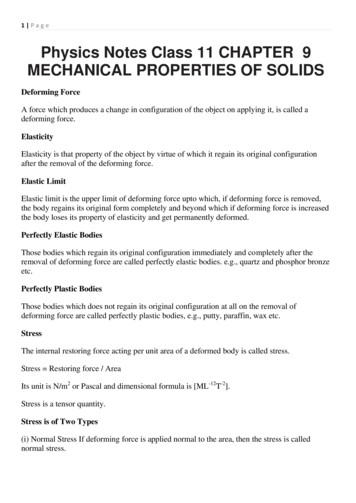
Transcription
1 PagePhysics Notes Class 11 CHAPTER 9MECHANICAL PROPERTIES OF SOLIDSDeforming ForceA force which produces a change in configuration of the object on applying it, is called adeforming force.ElasticityElasticity is that property of the object by virtue of which it regain its original configurationafter the removal of the deforming force.Elastic LimitElastic limit is the upper limit of deforming force upto which, if deforming force is removed,the body regains its original form completely and beyond which if deforming force is increasedthe body loses its property of elasticity and get permanently deformed.Perfectly Elastic BodiesThose bodies which regain its original configuration immediately and completely after theremoval of deforming force are called perfectly elastic bodies. e.g., quartz and phosphor bronzeetc.Perfectly Plastic BodiesThose bodies which does not regain its original configuration at all on the removal ofdeforming force are called perfectly plastic bodies, e.g., putty, paraffin, wax etc.StressThe internal restoring force acting per unit area of a deformed body is called stress.Stress Restoring force / AreaIts unit is N/m2 or Pascal and dimensional formula is [ML-12T-2].Stress is a tensor quantity.Stress is of Two Types(i) Normal Stress If deforming force is applied normal to the area, then the stress is callednormal stress.
2 PageIf there is an increase in length, then stress is called tensile stress.If there is a decrease in length, then stress is called compression stress.(ii) Tangential Stress If deforming force is applied tangentially, then the stress is calledtangential stress.StrainThe fractional change in configuration is called strain.Strain Change in the configuration / Original configurationIt has no unit and it is a dimensionless quantity.According to the change in configuration, the strain is of three types(1) Longitudinal strain Change in length / Original length(2) Volumetric strain Change in volume / Original volume(iii) Shearing strain Angular displacement of the plane perpendicular to the fixed surface.Hooke’s LawWithin the limit of elasticity, the stress is proportional to the strain.Stress &infi; Strainor Stress E * Strainwhere, E is the modulus of elasticity of the material of the body.Types of Modulus of Elasticity1. Young’s Modulus of ElasticityIt is defined as the ratio of normal stress to the longitudinal strain Within the elastic limit.y Normal stress / Longitudinal strainy FΔl / Al Mg Δl / πr2lIts unit is N/m2 or Pascal and its dimensional formula is [ML-1T-2].2. Bulk Modulus of Elasticity
3 PageIt is defined as the ratio of normal stress to the volumetric strain within the elastic limit.K Normal stress / Volumetric strainK FV / A ΔV &DElta;p V / Δ Vwhere, Δp F / A Change in pressure.Its unit is N/m2 or Pascal and its dimensional formula is [ML-1T-2].3. Modulus of Rigidity (η)It is defined as the ratio of tangential stress to the shearing strain, within the elastic limit.η Tangential stress / Shearing strainIts urut is N/m2 or Pascal and its dimensional formula is [ML-1T-2].CompressibilityCompressibility of a material is the reciprocal of its bulk modulus of elasticity.Compressibility (C) 1 / kIts SI unit is N-1m2 and CGS unit is dyne-1 cm2.Steel is more elastic than rubber. Solids are more elastic and gases are least elastic.For liquids. modulus of rigidity is zero.Young’s modulus (Y) and modulus of rigidity (η) are possessed by solid materials only.Limit of ElasticityThe maximum value of deforming force for which elasticity is present in the body is called itslimit of elasticity.Breaking StressThe minimum value of stress required to break a wire, is called breaking stress.Breaking stress is fixed for a material but breaking force varies with area of cross-section of thewire.Safety factor Breaking stress / Working stressElastic Relaxation Time
4 PageThe time delay in restoring the original configuration after removal of deforming force is calledelastic relaxation time.For quartz and phosphor bronze this time is negligible.Elastic After EffectThe temporary delay in regaining the original configuration by the elastic body after theremoval of deforming force, is called elastic after effect.Elastic FatigueThe property of an elastic body by virtue of which its behaviour becomes less elastic under theaction of repeated alternating deforming force is called elastic fatigue.Ductile MaterialsThe materials which show large plastic range beyond elastic limit are called ductile materials,e.g., copper, silver, iron, aluminum, etc.Ductile materials are used for making springs and sheets.Brittle MaterialsThe materials which show very small plastic range beyond elastic limit are called brittlematerials, e.g., glass, cast iron, etc.ElastomersThe materials for which strain produced is much larger than the stress applied, with in the limitof elasticity are called elastomers, e.g., rubber, the elastic tissue of aorta, the large vesselcarrying blood from heart. etc.Elastomers have no plastic range.Elastic Potential Energy in a Stretched WireThe work done in stretching a wire is stored in form of potential energy of the wire.Potential energy U Average force * Increase in length 1 / 2 FΔl 1 / 2 Stress * Strain * Volume of the wireElastic potential energy per unit volume
5 PageU 1 / 2 * Stress * Strain 1 / 2 (Young’s modulus) * (Strain)2Elastic potential energy of a stretched spring 1 / 2 kx2where, k Force constant of spring and x Change in length.Thermal StressWhen temperature of a rod fixed at its both ends is changed, then the produced stress is calledthermal stress.Thermal stress F / A yαΔθwhere, α coefficient of linear expansion of the material of the rod.When temperature of a gas enclosed in a vessel is changed, then the thermal stress produced isequal to change in pressure (Δp)of the gas.Thermal stress Δ p Ky Δ θwhere, K bulk modulus of elasticity andγ coefficient of cubical expansion of the gas.Interatomic force constantK Yrowhere, ro interatomic distance.Poisson’s RatioWhen a deforming force is applied at the free end of a suspended wire of length 1 and radius R,then its length increases by dl but its radius decreases by dR. Now two types of strains areproduced by a single force.(i) Longitudinal strain &DElta;U l(ii) Lateral strain – Δ R/ R Poisson’s Ratio (σ) Lateral strain / Longitudinal strain – Δ R/ R / ΔU lThe theoretical value of Poisson’s ratio lies between – 1 and 0.5. Its practical value liesbetween 0 and 0.5.
6 PageRelation Between Y, K, η and σ(i) Y 3K (1 – 2σ)(ii) Y 2 η ( 1 σ)(iii) σ 3K – 2η / 2η 6K(iv) 9 / Y 1 / K 3 / η or Y 9K η / η 3KImportant Points Coefficient of elasticity depends upon the material, its temperature and purity but not onstress or strain.For the same material, the three coefficients of elasticity γ, η and K have differentmagnitudes.Isothermal elasticity of a gas ET ρ where, ρ pressure of the gas.Adiabatic elasticity of a gas Es γρwhere, γ Cp / Cv ratio of specific heats at constant pressure and at constant volume. Ratio between isothermal elasticity and adiabatic elasticity Es/ ET γ Cp / CvCantileverA beam clamped at one end and loaded at free end is called a cantilever.Depression at the free end of a cantilever is given byδ wl3 / 3YIGwhere, w load, 1 length of the cantilever,y Young’s modulus of elasticity, and IG geometrical moment of inertia.For a beam of rectangular cross-section having breadth b and thickness d.IG bd3 / 12For a beam of circular cross-section area having radius r,
7 PageI G π r4 / 4Beam Supported at Two Ends and Loaded at the MiddleDepression at middle δ wl3 / 48YIGTorsion of a Cylinderwhere, η modulus of rigidity of the material of cylinder,r radius of cylinder,and 1 length of cylinder,Work done in twisting the cylinder through an angle θW 1 / 2 Cθ2Relation between angle of twist (θ) and angle of shear (φ)rθ lφ or φ r / l θ
Elastic Fatigue The property of an elastic body by virtue of which its behaviour becomes less elastic under the action of repeated alternating deforming force is called elastic fatigue. Ductile Materials The materials which show large plastic range beyond elastic limit are called ductile materials, e.g., copper, silver, iron, aluminum, etc.











